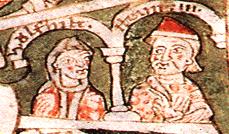Heinrich the Black
|
 |
Welf IV. became duke Welf I. of Bavaria in 1070, and when he died in 1101 his eldest son, Welf V. (1073-1120), became duke Welf II. of Bavaria. Around 1100 the younger son, Heinrich the Black, married Wulfhild of Saxony, the heiress of duke Magnus of Saxony. This marriage brought the Welfs powerful estates in the realm of Lüneburg. When his older brother died without descendents in 1120, Heinrich the Black inherited the duchy of Bavaria. In his last years of life, duke Heinrich the Black made the Welf house the most powerful family in the empire. He thus pursued successful marriage politics with his son Heinrich the Proud (1108-1139) and his daughter Judith. Above all, Heinrich the Black wanted to be close to the Saxon duke Lothair (1075-1137) of Süpplingenburg. After Lothair was elected German king Lothair III. in 1125 with Welf support, his daughter Gertrud married Heinrich the Proud (1100-1139), eldest son of Heinrich the Black, in 1125. This marriage bond brought the Welfs estates in the realm of Brunswick and Göttingen, and at the same time, beginning in 1137, it secured for the Welfs the title of duke of Saxony. Meanwhile, around 1120, Heinrich the Black's daughter Judith (1100-1131) had already married Friedrich II. of Swabia, from the house of Hohenstaufen. Judith was consequently the mother of the later emperor Friedrich I. Barbarossa (c. 1123-1190).
--Adapted from the website, Die Welfen
![]()
Sources
- The Encyclopedia Britannica CD 99.
- Schneidmüller, Bernd. Catalogue for the exhibition, "Heinrich der Löwe und seine Zeit." Brunswick, 1995.





